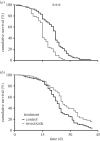Neonicotinoid insecticides can serve as inadvertent insect contraceptives
- PMID: 27466446
- PMCID: PMC4971197
- DOI: 10.1098/rspb.2016.0506
Neonicotinoid insecticides can serve as inadvertent insect contraceptives
Abstract
There is clear evidence for sublethal effects of neonicotinoid insecticides on non-target ecosystem service-providing insects. However, their possible impact on male insect reproduction is currently unknown, despite the key role of sex. Here, we show that two neonicotinoids (4.5 ppb thiamethoxam and 1.5 ppb clothianidin) significantly reduce the reproductive capacity of male honeybees (drones), Apis mellifera Drones were obtained from colonies exposed to the neonicotinoid insecticides or controls, and subsequently maintained in laboratory cages until they reached sexual maturity. While no significant effects were observed for male teneral (newly emerged adult) body mass and sperm quantity, the data clearly showed reduced drone lifespan, as well as reduced sperm viability (percentage living versus dead) and living sperm quantity by 39%. Our results demonstrate for the first time that neonicotinoid insecticides can negatively affect male insect reproductive capacity, and provide a possible mechanistic explanation for managed honeybee queen failure and wild insect pollinator decline. The widespread prophylactic use of neonicotinoids may have previously overlooked inadvertent contraceptive effects on non-target insects, thereby limiting conservation efforts.
Keywords: Apis mellifera; insecticide; pollination; reproduction; sperm; sub-lethal.
© 2016 The Authors.
Figures



References
-
- Oerke E-C. 2006. Crop losses to pests. J. Agric. Sci. 144, 31–43. (10.1017/S0021859605005708) - DOI
-
- Oberlander H, Silhacek DL. 2000. Insect growth regulators. In Alternatives to pesticides in stored-product IPM. New York, NY: Springer.
MeSH terms
Substances
Associated data
LinkOut - more resources
Full Text Sources
Other Literature Sources

